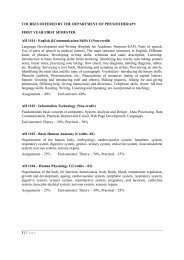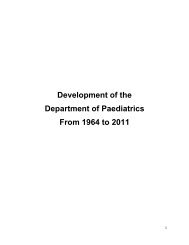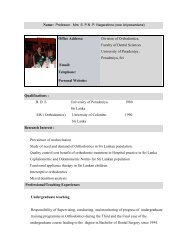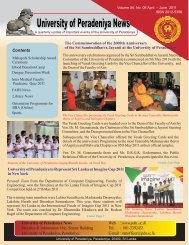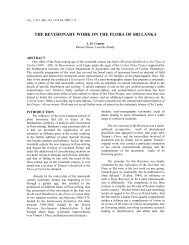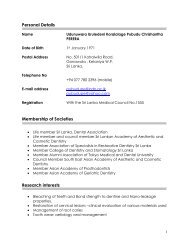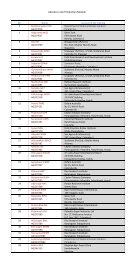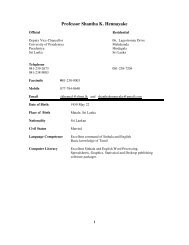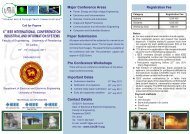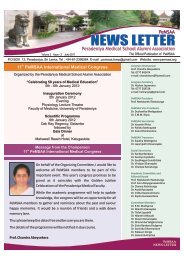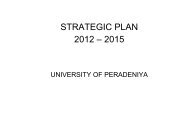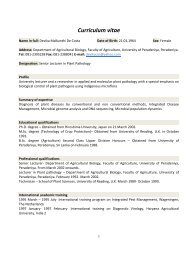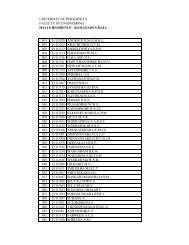PRESENT STATUS OF THE SHRIMP TRAWL FISHERY IN THE ...
PRESENT STATUS OF THE SHRIMP TRAWL FISHERY IN THE ...
PRESENT STATUS OF THE SHRIMP TRAWL FISHERY IN THE ...
You also want an ePaper? Increase the reach of your titles
YUMPU automatically turns print PDFs into web optimized ePapers that Google loves.
Shrimp trawl fishery in the west coast of Sri Lanka 35<br />
DISCUSSION<br />
The trawl fishery has a long history in Sri<br />
Lanka and Malpas (1926) made one of the earliest<br />
records of this fishery. In earlier times both<br />
exploratory and commercial fish trawling had been<br />
tried in the east coast particularly on Pedro Bank<br />
(Berg, 1971). There had been a few off shore<br />
trawling grounds in the past (Wadge Bank, Pedro<br />
Bank, Palk Bay and Gulf of Mannar). However,<br />
with the declaration of the 200 miles exclusive<br />
economic zone in 1976, Sri Lanka lost access to<br />
these fishing grounds partially or completely<br />
(Joseph, 1984).<br />
The findings of the present study indicated<br />
that the period from May-June until August-<br />
September is the best fishing season for the shrimp<br />
trawl fishery in the seas off Negombo and Hendala,<br />
which coincid with the south-west monsoon of the<br />
island. The statistical analysis has confirmed that<br />
the south-west monsoon has a significant influence<br />
on the shrimp catches from the trawl fishery (Tables<br />
2 & 3). The majority of penaeid shrimps possess<br />
both estuarine and the marine phases in their<br />
complex life cycles. Once the nursery life is<br />
completed in low saline lagoons, estuaries etc. they<br />
migrate back to coastal waters for reproduction (De<br />
Bruin, 1971). It is highly probable that the resultant<br />
osmotic stress due to low saline waters in the<br />
Negombo lagoon with the onset of inter-monsoon<br />
rains in April-May, induces the migration of preadults<br />
towards coastal areas for spawning. As<br />
penaeid shrimps form about 60-64% of the catch<br />
from the trawl fishery in this region, the high catch<br />
rates during the south west monsoon could<br />
presumably be due to the increased stock density in<br />
the trawling grounds owing to migration of shrimps<br />
to coastal areas for reproduction. The statistical<br />
analysis also provided sufficient evidence to justify<br />
that the sampling site has a great influence on the<br />
shrimp catches from the trawl fishery. This could<br />
presumably be due to the high efficiency of the<br />
mechanised crafts exploiting the southern trawling<br />
ground over the non-mechanised crafts which<br />
depend upon the existing wind force for fishing<br />
operations to a great extent. However, the modest<br />
shrimp catches from the trawling ground off<br />
Hendala (Fig. 1) could be partially explained by the<br />
reasonably high fishing effort by mechanised trawls<br />
particularly centred around June/July. In addition,<br />
loosing access to the substantial portion of the<br />
fishing ground owing to declaration of a security<br />
zone based on the Colombo harbour could<br />
presumably be the other reason for these modest<br />
catch rates.<br />
The catch rates of the shrimp trawl fishery<br />
in the seas off Negombo and Hendala though<br />
generally low could be compared with those of<br />
other trawl fisheries around the island. The present<br />
study indicates that non-mechanised and<br />
mechanised trawls have similar catch rates<br />
averaging 3.8 and 3.93 kg/hour respectively. For the<br />
trawl fishery in the north western coastal waters of<br />
Sri Lanka Jayawardane and Dayaratne (1998)<br />
reported a higher average catch rate of 5.28<br />
kg/hour. The estimated average catch rates for the<br />
shrimp trawl fishery in the seas off Chilaw<br />
however, for the periods 1979-80 and 1980-81 were<br />
closer to those of the north west coast at 4 and 2.5<br />
kg/hour respectively (Jayakody, 1984).<br />
Interestingly, the present catch rates were only<br />
slightly higher than the estimated average catch<br />
rates reported by Jayakody (1984) for the nonmechanised<br />
trawls operating in the seas off<br />
Negombo for the periods 1979-80 and 1980-81 (2.6<br />
and 2.9 kg/hour respectively). It was noted that<br />
even after about 20 years the catch rates of nonmechanised<br />
trawls remained almost unchanged<br />
even with the modest or slightly low catch rates.<br />
The estimated annual catch from<br />
mechanised trawls was 208 t in 1998 and 259 t in<br />
1999, an increase of around 25%. Similarly the<br />
shrimp catch and the fish catch from the<br />
mechanised trawls were also increased from 130<br />
and 78 t to 167 and 92 t respectively over the two<br />
years studied. However, this could be attributed to<br />
the substantial increase in the fishing effort of<br />
mechanised trawls from 7,854 fishing trips in 1998<br />
to 10,138 fishing trips in 1999 which is an increase<br />
of around 29%.<br />
The high percentage of shrimps in catches<br />
brings substantial economic returns to the trawl<br />
fishermen in the study area. Shrimps alone<br />
contribute to 60 and 64% of the total catch of nonmechanised<br />
and mechanised trawls respectively. On<br />
the other hand the by-catch of finfish makes less



